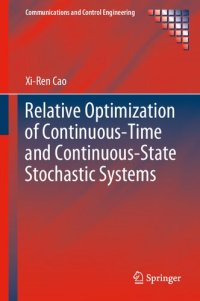
Ebook: Relative Optimization of Continuous-Time and Continuous-State Stochastic Systems
Author: Xi-Ren Cao
- Series: Communications and Control Engineering
- Year: 2020
- Publisher: Springer
- Edition: 1st ed. 2020
- Language: English
- pdf
This monograph applies the relative optimization approach to time nonhomogeneous continuous-time and continuous-state dynamic systems. The approach is intuitively clear and does not require deep knowledge of the mathematics of partial differential equations. The topics covered have the following distinguishing features: long-run average with no under-selectivity, non-smooth value functions with no viscosity solutions, diffusion processes with degenerate points, multi-class optimization with state classification, and optimization with no dynamic programming.
The book begins with an introduction to relative optimization, including a comparison with the traditional approach of dynamic programming. The text then studies the Markov process, focusing on infinite-horizon optimization problems, and moves on to discuss optimal control of diffusion processes with semi-smooth value functions and degenerate points, and optimization of multi-dimensional diffusion processes. The book concludes with a brief overview of performance derivative-based optimization.
Among the more important novel considerations presented are:
- the extension of the Hamilton–Jacobi–Bellman optimality condition from smooth to semi-smooth value functions by derivation of explicit optimality conditions at semi-smooth points and application of this result to degenerate and reflected processes;
- proof of semi-smoothness of the value function at degenerate points;
- attention to the under-selectivity issue for the long-run average and bias optimality;
- discussion of state classification for time nonhomogeneous continuous processes and multi-class optimization; and
- development of the multi-dimensional Tanaka formula for semi-smooth functions and application of this formula to stochastic control of multi-dimensional systems with degenerate points.
The book will be of interest to researchers and students in the field of stochastic control and performance optimization alike.